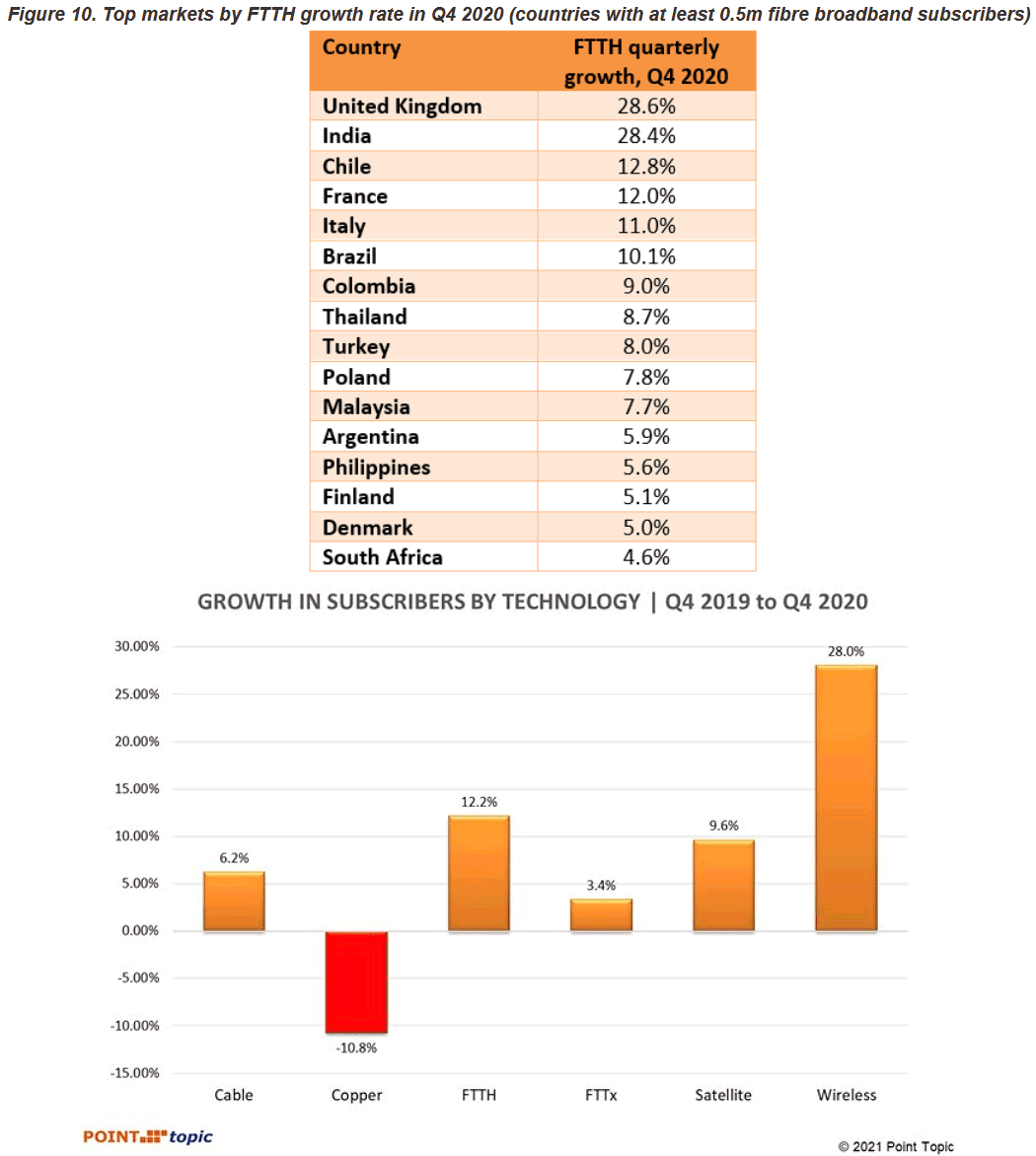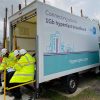Global Fixed Broadband Users Hit 1.18bn as UK FTTP Surges in Q4 2020

The latest research from Point Topic has found that world fixed broadband subscribers grew by 1.6% (18.59 million) in Q4 2020, which is down slightly from 2.07% in the previous quarter but still pushes the overall total to 1.18 billion. Meanwhile, the UK reported the strongest quarterly “full fibre” (FTTP) growth of any country on 28.6%.
Perhaps unsurprisingly, given China’s influence above, a little over 42% of all net additions in fixed broadband subscribers came from East Asia, which also retained the largest regional market share of all subscribers at 47%. By comparison the whole of Europe came in at 21%, while North America (USA, Canada) were next on 11.46% and the rest of Asia accounted for a market share of 10.13%.
The study also found that the highest “full fibre” (FTTP/H) broadband growth rates were mainly in the developing markets, with the United Kingdom (28.6%), India (28.4%) and Chile (12.8%) topping the table with quarterly growth rates in double figures. This is hardly surprising given the huge amount of private investment that is currently flooding into the UK (Summary of UK Full Fibre Build Progress).
Advertisement
As fibre growth increases then slower copper (ADSL) lines also tend to decline as subscribers upgrade. Globally, between Q4 2020 and Q4 2019, the number of pure copper lines fell by 10.8%, while FTTP connections increased by 12.2%. Interestingly wireless (mostly FWA) and satellite broadband connections also saw a healthy growth as these technologies are increasingly used to cover broadband slow spots (SpaceX’s Starlink may be helping here).

Mark is a professional technology writer, IT consultant and computer engineer from Dorset (England), he also founded ISPreview in 1999 and enjoys analysing the latest telecoms and broadband developments. Find me on X (Twitter), Mastodon, Facebook, BlueSky, Threads.net and Linkedin.
« Broadband and Mobile Policy by Political Party in Wales and Scotland
Broadband ISP Plusnet UK Predicted to Launch FTTP in H2 2021 »























































The FTTH percentage growth can be a bit misleading here because the UK started out from a very low level. nearly 80% of the UK still has no access to fibre broadband, this country is more than a decade behind of where it should be with regards to fibre broadband availability, nothing to be proud of. And there are no serious strategies and addressing the digital divide in this country. The whole policy framework needs to be changed for this.
Gnewton – incorrect as you well know – fibre broadband > 24 m/bps is now available to 97% of the UK population , full Fibre FTTP is now avilable to circa 20% -(you sound like that labour politician who got skewered on LBC) – he also had no clue either
Just because you dont like the way its been defined doesnt mean its wrong
@Fastman
To be fair, GNewton did specifically mention FTTH. I, for one, don’t view any copper-based xDSL service as “fibre broadband”, that’s a marketing ploy which seems to have stuck rather nicely.
‘this country is more than a decade behind of where it should be’
Say it often enough and people might believe you.
@The Facts: Yes, 20 years behind is more realistic. Thanks for pointing it out.
Concentrating on copper (and cable) broadband first means that the U.K. has widely available, easily affordable broadband to almost everywhere. If the focus had been on FTTP half the country would still be on dialup.
With your market insight it’s amazing you didn’t start your own ISP. You’d have easily made a fortune.
I’m assuming these reports come out at the end of each quarter? Would be nice Mark if you could keep us updated with these each time they come out so we can track quarter-on-quarter progress and then compare with how we’re doing against other countries.
They do Zak, but the public reports don’t always include the FTTP growth data for the top countries (we see that maybe once a year). We did previously cover these reports every quarter, but that felt too repetitive (not enough had changed), so we’ve found it better to do annual or biannual updates.
What is the breakdown between asymmetric and symmetric FTTP? The former has no future.
What’s your evidence for that?
“What’s your evidence for that?”
Evidence for what exactly?
Many will agree that symmetric fibre is far more useful for many professionals, so its amazing that the BT/Openreach clan doesn’t even offer it, forcing users to go for altnet’s where available.
Evidence that asymmetric services have no future. Unless people are going to start broadcasting their own 4K tv channels from home it seems unlikely.
BT does offer symmetric services, BTnet is symmetric. Virgin also offer symmetric services on their DIA product.
Large scale ISPs tend not to offer it on consumer broadband products because it increases the cost, and thus price, of the service. British consumers buy on price.
125US: BTs GPON / XG-PON based fibre lines are limited to a peak asymmetric speed of 1000Mbps download (220Mbps upload) for businesses (consumer tiers top out at 1000Mbps down / 115Mbps up). So I don’t know where you get your info from, you may want it to share with others here on ISPReview.
Simply use an Internet tool called Google and type in “BTnet” or “Virgin DIA”. I don’t believe these products are secret.
This article is not about leased lines, it’s about fibre broadband, and it is evident that BT can’t provide symmetric fibre broadband here, unlike some altnets.
You claimed symmetric fibre isn’t available. It is.
I agree with comment we are 10 years at least behind Europe in Europe they install Fibre not copper as standard
My home town no one has FTTP
my old house i moved 6 years ago i got 4 Mbps Adsl 25 Mbps FTTC
6 years later nothing changed Bt engineer that’s the max i will ever get Aluminum Lines what that means